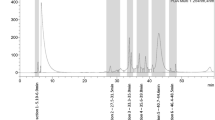Abstract
Phenethyl isothiocyanate (PEITC), an isothiocyanate abundantly found in cruciferous vegetables have been shown to induce apoptosis through MAPK pathway in prostate and colon cancer cells. In the present study, we investigate the effect of PEITC on cell cycle regulation of HT-29 colon cancer cells. Using flow cytometry and Western blot analyses, we found that PEITC significantly induced G1 cell cycle arrest in HT-29 cells. We showed that the cell cycle arrest was not related to beta-catenin translocation into the nucleus. Interestingly, inhibition of p38 attenuated the cell cycle arrest, suggesting that cell cycle arrest by PEITC was caused by the activation of MAPK pathway. Treatments of PEITC resulted in a dose-dependent down-regulation of cyclins A, D, E and pRb protein expression. The down-regulation can be attributed to the activation of the p38 pathway, since inhibition of its activities by specific inhibitor blocked PEITC’s ability to decrease the expression level of cyclins A and D and attenuate cell cycle arrest effect of PEITC. In conclusion, this study shows for the first time that PEITC can arrest HT-29 cells in G1 phase by down-regulation of cyclins through the activation of p38 MAPK signaling pathway.





Similar content being viewed by others
REFERENCE
P. A. Wingo, T. Tong, and S. Bolden. Cancer statistics. CA Cancer J. Clin. 45:8–30 (1995).
J. D. Potter. Nutrition and colorectal cancer. Cancer Causes and Control. 7:127–146 (1996).
J. W. Fahey, A. T. Zalcmann, and P. Talalay. The chemical diversity and distribution of glucosinolates and isothiocyanates among plants. Phytochemistry. 56:5–51 (2001).
Y. Zhang, and P. Talalay. Anticarcinogenic activities of organic isothiocyanates: chemistry and mechanisms. Cancer Res. 54:7 (1994).
C. Xu, G. Shen, X. Yuan, J. H. Kim, A. Gopalkrishnan, Y. S. Keum, S. Nair, and A. N. Kong. ERK and JNK signaling pathways are involved in the regulation of activator protein 1 and cell death elicited by three isothiocyanates in human prostate cancer PC-3 cells. Carcinogenesis. 3:437–445 (2006).
J. Hu, J. Straub, D. Xiao, S. V. Singh, H. S. Yang, N. Sonenberg, and J. Vatsyayan. Phenethyl isothiocyanate, a cancer chemopreventive constituent of cruciferous vegetables, inhibits cap-dependent translation by regulating the level and phosphorylation of 4E-BP1. Cancer Res. 67:8 (2007).
R. Hu, B. R. Kim, C. Chen, V. Hebbar, and A. N. Kong. The roles of JNK and apoptotic signaling pathways in PEITC-mediated responses in human HT-29 colon adenocarcinoma cells. Carcinogenesis. 8:1361–1367 (2003).
T. O. Khor, R. Hu, G. Shen, W. S. Jeong, V. Hebbar, C. Chen, C. Xu, S. Nair, B. Reddy, K. Chada, and A. N. Kong. Pharmacogenomics of cancer chemopreventive isothiocyanate compound sulforaphane in the intestinal polyps of ApcMin/ mice. Biopharm Drug Dispos. 9:407–420 (2006).
Y. M. Yang, M. Jhanwar-Uniyal, J. Schwartz, C. C. Conaway, H. D. Halicka, F. Traganos, and F. L. Chung. N-acetylcysteine conjugate of phenethyl isothiocyanate enhances apoptosis in growth-stimulated human lung cells. Cancer Res. 18:8538–8547 (2005).
F. Cong, J. Zhang, W. Pao, P. Zhou, and H. Varmus. A protein knockdown strategy to study the function of beta-catenin in tumorigenesis. BMC Mol Biol. 4:10 (2003).
N. D. Perkins. Integrating cell signaling pathways with NF-KB and IKK function. Nat Rev Mol Cell Biol. 1:49–62 (2007).
H. C. Reinhardt, A. S. Aslanian, J. A. Lees, and M. B. Yaffe. p53-deficient cells rely on ATM- and ATR-mediated checkpoint signaling through the p38MAPK/MK2 pathway for survival after DNA damage. Cancer Cell. 2:175–189 (2007).
C. Norbury, J. Blow, and P. Nurse. Regulatory phosphorylation of the p34cdc2 protein kinase in vertebrates. EMBO J. 11:3321–3329 (1991).
ACKNOWLEDGEMENT
We thank all the members in Dr. Tony Kong’s lab for their help in the discussion and preparation of this manuscript. This work was supported in part by National Institute of Health Grant R01 CA-073674-07.
Author information
Authors and Affiliations
Corresponding author
Rights and permissions
About this article
Cite this article
Cheung, K.L., Khor, T.O., Yu, S. et al. PEITC Induces G1 Cell Cycle Arrest on HT-29 Cells Through the Activation of p38 MAPK Signaling Pathway. AAPS J 10, 277–281 (2008). https://doi.org/10.1208/s12248-008-9032-9
Received:
Accepted:
Published:
Issue Date:
DOI: https://doi.org/10.1208/s12248-008-9032-9




